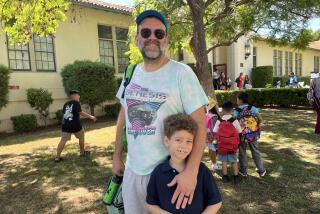Maligned District’s Muscle Comes In Handy in Crisis
When San Fernando Elementary School reopens this morning, two weeks after it was heavily damaged in the Northridge earthquake, it won’t be just because of the hard work of Principal Candida Fernandez-Ghoneim and her dedicated staff.
It’ll also be because of the behemoth Los Angeles Unified School District. It used its influence with state and federal officials to marshal assistance for San Fernando Elementary and other schools damaged in the San Fernando Valley, where, ironically, sentiment to break up the 640,000-student district is the strongest.
“We couldn’t have reopened without the state and the (school) district,” said Fernandez-Ghoneim as she surveyed her campus the other day. “They’ve been wonderful. We have gotten more resources because we are a unified district. We’ve had fires and riots. Who knows who’ll get hit next?
“I don’t think the breakup (of the school district) is the answer at all.”
*
Fernandez-Ghoneim echoed a view held by many Latino educators and activists: They were glad the bill to break up the L.A. school district died in the state Legislature last year, but worried what a new calamity would do to the financially strapped district.
The school system has been like a bloodied boxer on the ropes, desperately trying to stay on its feet. The threatened teacher strike over shrinking salaries was one shot to the gut, and program cutbacks due to decreasing state aid were a damaging blow to the head. The LEARN program, a new approach to decentralizing the educational curriculum, was seen as a way to placate critics.
When damage estimates to school property from the 6.6 magnitude quake were put at $700 million, many had the same frustrated reaction as did school board President Leticia Quezada, who lamented, “How can we take one more crisis? This is so devastating it could cause someone to literally throw up their hands, find a hole and disappear.”
Instead of doing that, the L.A. school district has shown some political muscle in marshaling relief efforts.
Early on, school board members met with James Lee Witt, the head of the Federal Emergency Management Agency, who vowed to help repair some 150 schools, including San Fernando Elementary, which was one of the most severely damaged by the quake. Other federal officials were quickly persuaded to follow suit.
District officials also persuaded state officials to provide 200 portable classrooms to temporarily replace those rendered unsafe.
Latino activists who shared Quezada’s frustration were glad to see the often-maligned district still has influence. “Can you imagine if there were five, six or seven smaller districts and they were all fighting for some earthquake aid?” wondered Eastside activist Marshall Diaz. “The district is so big and powerful and influential that we can jam the state and the federal government to get things for us.”
In the case of San Fernando Elementary, Quezada and other school officials were sure no one else could step in to ensure its reopening today. Even the city of San Fernando--a predominantly Latino blue-collar town that takes enormous pride in the school, founded in the late 1800s--could render little assistance because of its own problems caused by the quake.
Two of the school’s bungalows were knocked off their foundations and several 1920s-vintage classroom buildings were rendered unsafe for students because of structural damage. The school auditorium was declared safe by inspectors but Fernandez-Ghoneim has decided against using it because of large cracks in the building’s ceiling.
Quezada, hearing that bureaucrats weren’t going to meet the school’s needs for portable classrooms, leaned on them to reverse field and give eight to the school. Federal and state officials who visited the school vowed to provide everything from security to textbooks.
*
Meanwhile, maintenance workers from all over the school district, aided by a detachment of National Guard soldiers, swarmed over the campus to clean up debris and restore essential services. Food, water and school supplies have been stockpiled in anticipation of today’s resumption of classes.
Arrangements have been made for several psychologists to be on hand to help parents and students overcome any misgivings about the school’s reopening.
Above all else, Fernandez-Ghoneim wants to make sure the 1,150 students who return to school have a sense of stability back in their lives.
That’s what the Los Angeles Unified School District has given the damaged schools in the Valley in this crisis.
More to Read
Sign up for Essential California
The most important California stories and recommendations in your inbox every morning.
You may occasionally receive promotional content from the Los Angeles Times.










